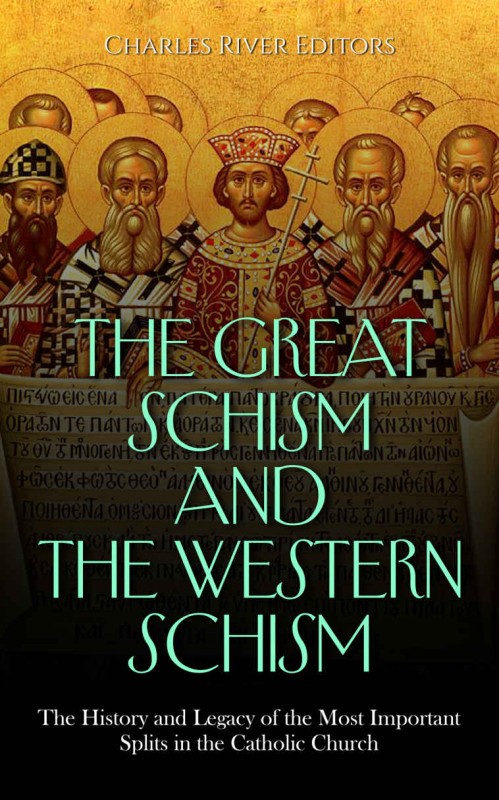Receive your first E-Book(s) on us valued up to $10, simply by registering an account today.
The Great Schism and the Western Schism: The History and Legacy of the Most Important Splits in the Catholic Church
$4.99
Categories History, Religion
Tag Charles River Editors
 Purchase this item and get 9 Points - a worth of $0.90
Purchase this item and get 9 Points - a worth of $0.90For nearly a thousand years following its foundation, there was only one Christian Church. Centered in the city of Rome, the Church expanded and grew until it became the dominant religion in Europe and beyond. The early growth of the Church had been suppressed by the Romans until the Emperor Constantine became the first to convert the empire to Christianity, and from that point forward, the growth of the Church Was inextricably linked with the Roman Empire, the most powerful military, economic, and political force in the ancient world.After the defeat of Carthage in the Second Punic War in 201 BCE, Rome was one of the most important cities in the world, but things were beginning to change around the time Constantine converted the empire in the early 4th century. Rome controlled large areas of the world, but by the 4th century the emphasis had shifted from military conquest to the control of lucrative trade routes. The problem was that the city of Rome, isolated in the southern half of the Italian peninsula, was far from these routes, and this compelled Constantine to establish a major Roman city on the site of ancient Byzantium. The new city, Constantinople, was located on a strategic site controlling the narrow straits between the Black Sea and the Aegean, meaning it was firmly astride some of the most important trade routes in the ancient world between Europe and Asia and between the Mediterranean and the Black Sea.Constantinople became the second most important city of the Roman Empire, thriving in parallel with Rome, but then the empire split into Eastern and Western provinces, with Constantinople the capital of the east and Rome the capital of the west. Control of trade routes made Constantinople increase in power and influence while Rome became less important.In 476, the process was completed when Rome was attacked and sacked by invading Goths, while Constantinople survived the foreign invasions, mainly by paying large bribes to keep the Goths and Huns at bay. Power shifted entirely to Constantinople, and the Latin-speaking Roman Empire evolved into the Greek-speaking Byzantine Empire. Rome, once the most important city in the world, was all but abandoned.However, not all power and influence shifted east, because one important institution remained firmly linked with the city of the Bishops of the Church. Under the rule of previous emperors, Christian Bishops had not only been formally recognized, but had been given power within the Roman state. The most important of all was I Sommi Pontefici Romani” the supreme pontiff of Rome. The earliest holders of this title were martyrs and saints of the Church, but by the time of the rise of Constantinople, this role was elected by the other Bishops of the Church. This role would later become known as the Pope (from the Greek word “pappas” meaning “father”), but even before that title was adopted, the Supreme Pontiff in Rome was widely recognized as the leader of the Church. In historical terms, these early leaders of the Church are often referred to as “popes” even though that title was not formally adopted until after the division of the Church.Rome’s preeminence was not a situation that was welcomed in Constantinople, now the center of the Byzantine Empire and a thriving and wealthy metropolis. After being sacked by outsiders, Rome had become a virtual ghost town, partially ruined and inhabited by a small number of hardy survivors, yet in the center of the crumbling city was the Vatican Borgo, the Palace of the Supreme Pontiff and the heart of the Church. In retrospect, it is easy to see that this was a situation that was bound to lead to conflict and disagreement, with the Greek-speaking Eastern Orthodox Church centered in Constantinople and being governed by Latin-speaking popes in a faraway
| Book Author: | Charles River Editors |
|---|---|
| Language: | English |
| Pages: | 89 |
| Publisher: | Charles River Editors |
| Publication Date: | 2022 |
| Format: | iPhones/iPads/Mac (Apple Books), Androids/PCs (Google Play), Kobo, Nook, Kindle |
Only logged in customers who have purchased this product may leave a review.
Best seller of the week
-
The Paper Lion
$10.99Original price was: $10.99.$8.99Current price is: $8.99.Rated 0 out of 5Add to cart -
Put Me in the Zoo
$10.99Original price was: $10.99.$8.99Current price is: $8.99.Rated 0 out of 5Add to cart -
The Password to Larkspur Lane
$9.99Original price was: $9.99.$7.99Current price is: $7.99.Rated 0 out of 5Add to cart
















Reviews
There are no reviews yet.